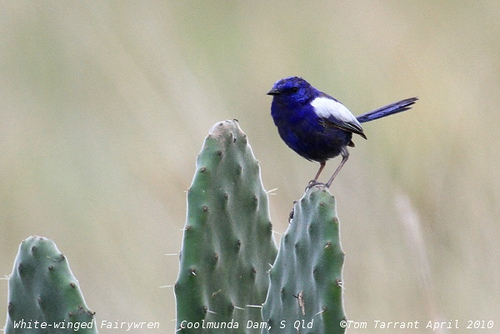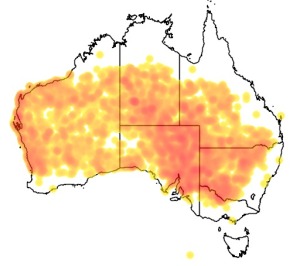Colours
Distinguishing features
Averaging 8.5 mm in males and 8.4 mm in females, the bill is relatively long, narrow and pointed and wider at the base. Wider than it is deep, the bill is similar in shape to those of other birds that feed by probing for or picking insects off their environs. It is finer and more pointed in this species than in other fairywrens.
Fully mature adults are sexually dimorphic, with the male being larger and differing in colour from the female. The adult female is sandy-brown with a very light blue tail, and a pinkish buff bill. The male in breeding plumage has a black bill, white wings and shoulders, and a wholly cobalt blue or black body (depending on subspecies). These contrasting white feathers are especially highlighted in flight and ground displays in breeding season. The male in eclipse plumage resembles the female, though it may be distinguished by its darker bill.
Both sexes have long, slender, distinct tails held at an upward angle from their bodies. Measuring around 6.25 cm, the tail feathers have a white fringe, which disappears with wear.
Nestlings, fledglings, and juveniles have brown plumage and pink-brown bills with shorter tails than adults. Young males develop blue tail feathers and darker bills by late summer or autumn (following a spring or summer breeding season), while young females develop light blue tails. By the subsequent spring, all males are fertile and have developed cloacal protuberances, which store sperm. In contrast, during the breeding season, fertile females develop oedematous brood patches, which are bare areas on their bellies. Males entering their second or third year may develop spotty blue and white plumage during the breeding season. By their fourth year, males have assumed their nuptial plumage, where the scapulars, secondary wing coverts, and secondary flight feathers are white while the rest of their bodies are a vibrant cobalt blue.
All sexually mature males moult twice a year, once before the breeding season in winter or spring, and again afterwards in autumn; rarely, a male may moult directly from nuptial to nuptial plumage.
The breeding males' blue plumage, particularly the ear-coverts, is highly iridescent due to the flattened and twisted surface of the barbules. The blue plumage also reflects ultraviolet light strongly, and so may be even more prominent to other fairywrens, whose colour vision extends into this part of the spectrum. (Wikipedia)
Size
- From 11 cm to 13.5 cm (Length of specimen)
Wingspan
- Wingspan data is not yet available.
Synonyms
Interesting facts
- Both the male and female adult White-winged Fairy-wren may utilise a rodent-run display to distract predators from nests with young birds. The head, neck and tail are lowered, the wings are held out and the feathers are fluffed as the bird runs rapidly and voices a continuous alarm call. (Wikipedia)
Distribution
Diet
The White-winged Fairywren is primarily insectivorous; its diet includes small beetles, bugs, moths, praying mantises, caterpillars, and smaller insects, including spiders. The larger insects are typically fed to nestlings by the breeding female and her helpers, including the breeding male. Adults and juveniles forage by hopping along the shrubland floor, and may supplement their diets with seeds and fruits of Saltbush (Rhagodia), Goosefoot (Chenopodium) and new shoots of Samphire.
During spring and summer, birds are active in bursts through the day and accompany their foraging with song. Insects are numerous and easy to catch, which allows the birds to rest between forays. The group often shelters and rests together during the heat of the day.
Food is harder to find during winter and they are required to spend the day foraging continuously. (Wikipedia)


